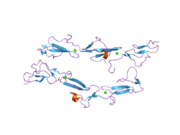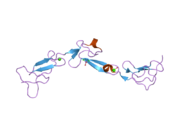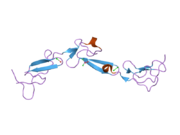Biology:EMR2
 Generic protein structure example |
EGF-like module-containing mucin-like hormone receptor-like 2 also known as CD312 (cluster of differentiation 312) is a protein encoded by the ADGRE2 gene.[1] EMR2 is a member of the adhesion GPCR family.[2][3] Adhesion GPCRs are characterized by an extended extracellular region often possessing N-terminal protein modules that is linked to a TM7 region via a domain known as the GPCR-Autoproteolysis INducing (GAIN) domain.[4]
EMR2 is expressed by monocytes/macrophages, dendritic cells and all types of granulocytes.[5] In the case of EMR2 the N-terminal domains consist of alternatively spliced epidermal growth factor-like (EGF-like) domains. EMR2 is closely related to CD97 with 97% amino-acid identity in the EGF-like domains. The N-terminal fragment (NTF) of EMR2 presents 2-5 EGF-like domains in human.[6] Mice lack the Emr2 gene.[7] This gene is closely linked to the gene encoding EGF-like molecule containing mucin-like hormone receptor 3 EMR3 on chromosome 19.
Ligand
Like the related CD97 protein, the fourth EGF-like domain of EMR2 binds chondroitin sulfate B to mediate cell attachment.[8] However, unlike CD97 EMR2 does not interact with the complement regulatory protein, decay accelerating factor CD55, and indicating that these very closely related proteins likely have nonredundant functions.[9]
Signaling
Inositol phosphate (IP3) accumulation assays in overexpressing HEK293 cells have demonstrated coupling of EMR2 to Gα15.[10] EGF-like module-containing mucin-like hormone receptor-like 2 (EMR2) is an adhesion GPCR that undergoes GPS autoproteolysis before being trafficked to the plasma membrane.[11] Further, distribution, translocation, co-localization of the N-terminal fragment (NTF) and N-terminal fragment (CTF) of EMR2 within lipid rafts may affect cell signaling.[12] Mutations in the GPS have shown that EMR2 does not need to undergo autoproteolysis to be trafficked, but loses function. EMR2 has been shown to be necessary for in vitro cell migration. Upon cleavage the N-terminus has been shown to associate with the 7TM, but to also dissociate, giving two possible functions. When the N-terminus dissociates it can be found in lipid rafts. Additionally, the cleaved EMR2 protein 7TM has been found to associate with EMR4 N-terminus.
Function
The expression of EMR2 and CD97 on activated lymphocytes and myeloid cells promotes binding with their ligand chondroitin sulfate B on peripheral B cells, indicating a role in leukocyte interaction.[13] The interaction between EMR2 and chondroitin sulfate B in inflamed rheumatoid synovial tissue suggests a role of the receptors in the recruitment and retention of leukocytes in synovium of arthritis patients.[14] Upon neutrophil activation, EMR2 rapidly moves to membrane ruffles and the leading edge of the cell. Additionally, ligation of EMR2 by antibody promotes neutrophil and macrophage effector functions suggesting a role in potentiating inflammatory responses.[12][15]
Clinical significance
EMR2 is rarely expressed by tumor cell lines and tumors, but has been found on breast and colorectal adenocarcinoma.[16][17] In breast cancer, robust expression and different distribution of EMR2 is inversely correlated with survival.[18] Gain of function mutations within the GAIN domain of EMR2 of certain patient cohorts were shown to result in excessive degranulation by mast cells resulting in vibratory urticaria[19]
See also
References
- ↑ "International Union of Basic and Clinical Pharmacology. XCIV. Adhesion G protein-coupled receptors". Pharmacological Reviews 67 (2): 338–67. April 2015. doi:10.1124/pr.114.009647. PMID 25713288.
- ↑ Stacey M, Yona S (2011). Adhesion-GPCRs: Structure to Function (Advances in Experimental Medicine and Biology). Berlin: Springer. ISBN 978-1-4419-7912-4.
- ↑ "Sticky signaling--adhesion class G protein-coupled receptors take the stage". Science Signaling 6 (276): re3. May 2013. doi:10.1126/scisignal.2003825. PMID 23695165.
- ↑ "A novel evolutionarily conserved domain of cell-adhesion GPCRs mediates autoproteolysis". The EMBO Journal 31 (6): 1364–78. March 2012. doi:10.1038/emboj.2012.26. PMID 22333914.
- ↑ "Human EMR2, a novel EGF-TM7 molecule on chromosome 19p13.1, is closely related to CD97". Genomics 67 (2): 188–200. July 2000. doi:10.1006/geno.2000.6238. PMID 10903844.
- ↑ "F4/80 and the related adhesion-GPCRs". European Journal of Immunology 41 (9): 2472–6. September 2011. doi:10.1002/eji.201141715. PMID 21952799.
- ↑ "An unusual mode of concerted evolution of the EGF-TM7 receptor chimera EMR2". FASEB Journal 20 (14): 2582–4. December 2006. doi:10.1096/fj.06-6500fje. PMID 17068111.
- ↑ "The epidermal growth factor-like domains of the human EMR2 receptor mediate cell attachment through chondroitin sulfate glycosaminoglycans". Blood 102 (8): 2916–24. October 2003. doi:10.1182/blood-2002-11-3540. PMID 12829604.
- ↑ "The human EGF-TM7 family member EMR2 is a heterodimeric receptor expressed on myeloid cells". Journal of Leukocyte Biology 71 (5): 854–62. May 2002. doi:10.1189/jlb.71.5.854. PMID 11994511.
- ↑ "Signaling property study of adhesion G-protein-coupled receptors". FEBS Letters 586 (8): 1214–9. April 2012. doi:10.1016/j.febslet.2012.03.014. PMID 22575658.
- ↑ "Autocatalytic cleavage of the EMR2 receptor occurs at a conserved G protein-coupled receptor proteolytic site motif". The Journal of Biological Chemistry 279 (30): 31823–32. July 2004. doi:10.1074/jbc.M402974200. PMID 15150276.
- ↑ 12.0 12.1 "Activation of myeloid cell-specific adhesion class G protein-coupled receptor EMR2 via ligation-induced translocation and interaction of receptor subunits in lipid raft microdomains". Molecular and Cellular Biology 32 (8): 1408–20. April 2012. doi:10.1128/MCB.06557-11. PMID 22310662.
- ↑ "Expression of the largest CD97 and EMR2 isoforms on leukocytes facilitates a specific interaction with chondroitin sulfate on B cells". Journal of Leukocyte Biology 77 (1): 112–9. January 2005. doi:10.1189/jlb.0704402. PMID 15498814.
- ↑ "Identification of the epidermal growth factor-TM7 receptor EMR2 and its ligand dermatan sulfate in rheumatoid synovial tissue". Arthritis and Rheumatism 52 (2): 442–50. February 2005. doi:10.1002/art.20788. PMID 15693006.
- ↑ "Ligation of the adhesion-GPCR EMR2 regulates human neutrophil function". FASEB Journal 22 (3): 741–51. March 2008. doi:10.1096/fj.07-9435com. PMID 17928360. http://www.fasebj.org/content/22/3/741.long.
- ↑ "Detection of alternatively spliced EMR2 mRNAs in colorectal tumor cell lines but rare expression of the molecule in colorectal adenocarcinomas". Virchows Archiv 443 (1): 32–7. July 2003. doi:10.1007/s00428-003-0812-4. PMID 12761622.
- ↑ "CD97, but not its closely related EGF-TM7 family member EMR2, is expressed on gastric, pancreatic, and esophageal carcinomas". American Journal of Clinical Pathology 118 (5): 699–707. November 2002. doi:10.1309/A6AB-VF3F-7M88-C0EJ. PMID 12428789.
- ↑ "Leukocyte adhesion-GPCR EMR2 is aberrantly expressed in human breast carcinomas and is associated with patient survival". Oncology Reports 25 (3): 619–27. March 2011. doi:10.3892/or.2010.1117. PMID 21174063.
- ↑ "Vibratory Urticaria Associated with a Missense Variant in ADGRE2". The New England Journal of Medicine 374 (7): 656–63. February 2016. doi:10.1056/NEJMoa1500611. PMID 26841242.
External links
 |




